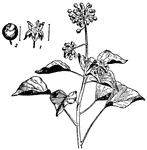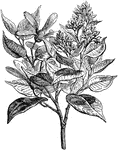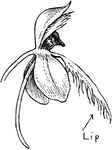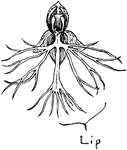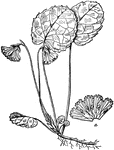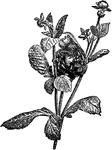
Dahlia
An illustration of a double variety dahlia flower. Dahlia is a genus of bushy, tuberous, perennial plants…

Bulrush
"1. Flowering plant of Bulrush (Scirpus lacustris). 2. The inflorescence. a, a flower; b, the fruit."…

Common Comfrey
The Common Comfrey (Symphytum officinale) is a flowering plant in the Boraginaceae family. Here showing…

Hops
The hop (Humulus) is a small genus of flowering plants, native to the temperate Northern Hemisphere.…

Crocus
Crocus (plural: crocus, crocuses) is a genus of perennial flowering plants, native to a large area from…

Canada Thistle
Cirsium arvense is a species of Cirsium, native throughout Europe and northern Asia, and widely introduced…

Safflower
Safflower (Carthamus tinctorius L.) is a highly branched, herbaceous, thistle-like annual, usually with…

Maryland Figwort
"The inflorescence of Maryland Figwort (Scrophularia Marylandica). a, the flower; b, the fruit; c, a…

Egyptian Floral Ornament Form
Externally the temples presented only masses of unbroken wall; but these, as well as the pylons, were…

Assyrian Ornament
The purely conventional ornaments — the rosette, guilloche, and lotus-flower, and probably also…

Gutta-percha
An illustration of the flower (a) and the fruit (b) of the gutta-percha. Gutta-percha (Palaquium) is…

Hound's Tongue
Cynoglossum officinale (hound's tongue, dog's tongue, gypsy flower, and rats and mice due to its smell)…
![An illustration showing a "floral diagram of [the' Viola [plant], showing arrangement of parts in horizontal plan. b, pair of bractoeles below the flower; s, sepals; p, petals; st, stamens; o, ovary" (Britannica, 102).](https://etc.usf.edu/clipart/58100/58119/58119_viola-dia_mth.gif)
Viola Diagram
An illustration showing a "floral diagram of [the' Viola [plant], showing arrangement of parts in horizontal…

Resurrection Plant
The fertile plant of the Resurrection Plant (Selaginella lepidophylla), a spikemoss which lives in deserts.

Self-Heal
"Self-heal. (Prunella vulgaris). The upper part of the stem with flowers. a, the calyx; b, the corolla;…
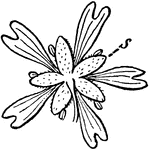
Nodding Chickweed
"c, flower of Cerastium longipedunculatum, seen from below: s, a sepal." -Whitney, 1911

Nodding Chickweed
"d, calyx, showing the five free sepals" of the Nodding Chickweed (Cerastium nutans) -Whitney, 1911

Jasminum grandiflorum
Jasminum grandiflorum (chameli in Hindi) is a species of jasmine native to South Asia. In India, its…
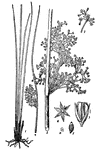
Soft Rush
An illustrative view of the soft rush. 1, plant; 2, inflorescence; 3, end of branch of inflorescence;…
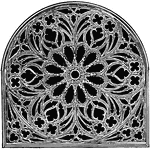
Rose Window, Church of St. Ouen, Rouen
A Rose window (or Catherine window) is often used as a generic term applied to a circular window, but…
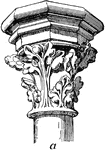
French Gothic Capital
A French Gothic capital from Sainte Chapelle in Paris from the thirteenth century. The capitals were…

Poppy Septa
"Fruit of Poppy, cut transversely to show the 12 septa (S) with the seeds." -Whitney, 1911

Poppy Septa
"Diagram of fruit of Poppy, cut transversely to show the 12 septa (S) with the seeds omitted." -Whitney,…
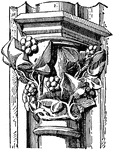
French Gothic Capital
A fourteenth century capital from transept of Notre Dame, Paris. The capitals were tall and slender,…

French Gothic Capital
A fifteenth century capital from the north spire of Chartres. The capitals were tall and slender, concave…

Dodder
An illustration of Dodder including: 1, flower removed from; 2, Calyx; Ovary cut acrossed; 4, fruit…

Duckweed Inflorescence
An illustration of duckweed inflorescence containing two male flowers each of one stamen and a female…
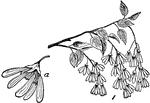
Canadian Serviceberry
A branch of the Canadian Serviceberry (Amelanchier canadensis), a shrub or small tree, showing flowers.

Sesame
The Sesame (Sesamum orientale, Sesamum indicum) is a flowering plant in the Pedaliaceae family of pedaliums…
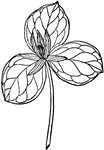
Toadshade
The Toadshade (Trillium sessile) is a spring wildflower in the Melanthiaceae family of herbs and trilliums.

Sessile Bellwort
The Sessile Bellwort (Uvularia sessilifolia) is a species of bellworts, here showing its sessile leaves.

Tuberous Grass Pink
The Tuberous Grass Pink (Calopogon tuberosus) is an orchid native to the eastern United States from…

Tuberous Grass Pink
The Tuberous Grass Pink (Calopogon tuberosus) is an orchid native to the eastern United States from…

Chay Root
The Chay Root (Oldenlandia umbellata) is a plant native to India used for the red dye that can be extracted…

Shepherd's Purse
"Plant with Flowers and Fruits of Shepherd's-purse" (Capsella bursa-pastoris) "a, flower; b, a pod."…
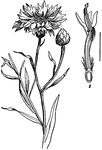
Cornflower
It is an annual plant growing to 40-90 cm tall, with grey-green branched stems. The leaves are lanceolate,…

Simarouba
"Branch of Simarouba amara, with female flowers. a, a male flower; b, a female flower." -Whitney, 1911

Blowout Grass
Blowout Grass (Redfieldia flexuosa) is a grass found on sand dunes. "a, spikelet; b, flower; c,…

Indian Pillar from the Rock Temple of Parasona Rama at Ellora
Jain caves reveal specific dimensions of Jain philosophy and tradition. They reflect a strict sense…

Interior of Indra Sabha at Ellora
Jain caves reveal specific dimensions of Jain philosophy and tradition. They reflect a strict sense…

Indian Pillar at Ellora
Jain caves reveal specific dimensions of Jain philosophy and tradition. They reflect a strict sense…

Proliferous Rose
A diagram of a prolific rose illustrating: s, Sephals transformed into leaves; p, Petals multiplied…
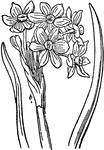
Narcissus
Narcissus is the botanic name for a genus of mainly hardy, mostly spring-flowering, bulbs in the Amaryllis…
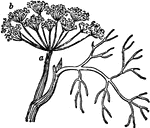
Dill
Dill (Anethum graveolens) is a short-lived perennial herb. It is the sole species of the genus Anethum,…

Lamium Album
Lamium album (White Deadnettle) is a flowering plant in the family Lamiaceae, native throughout Europe…





